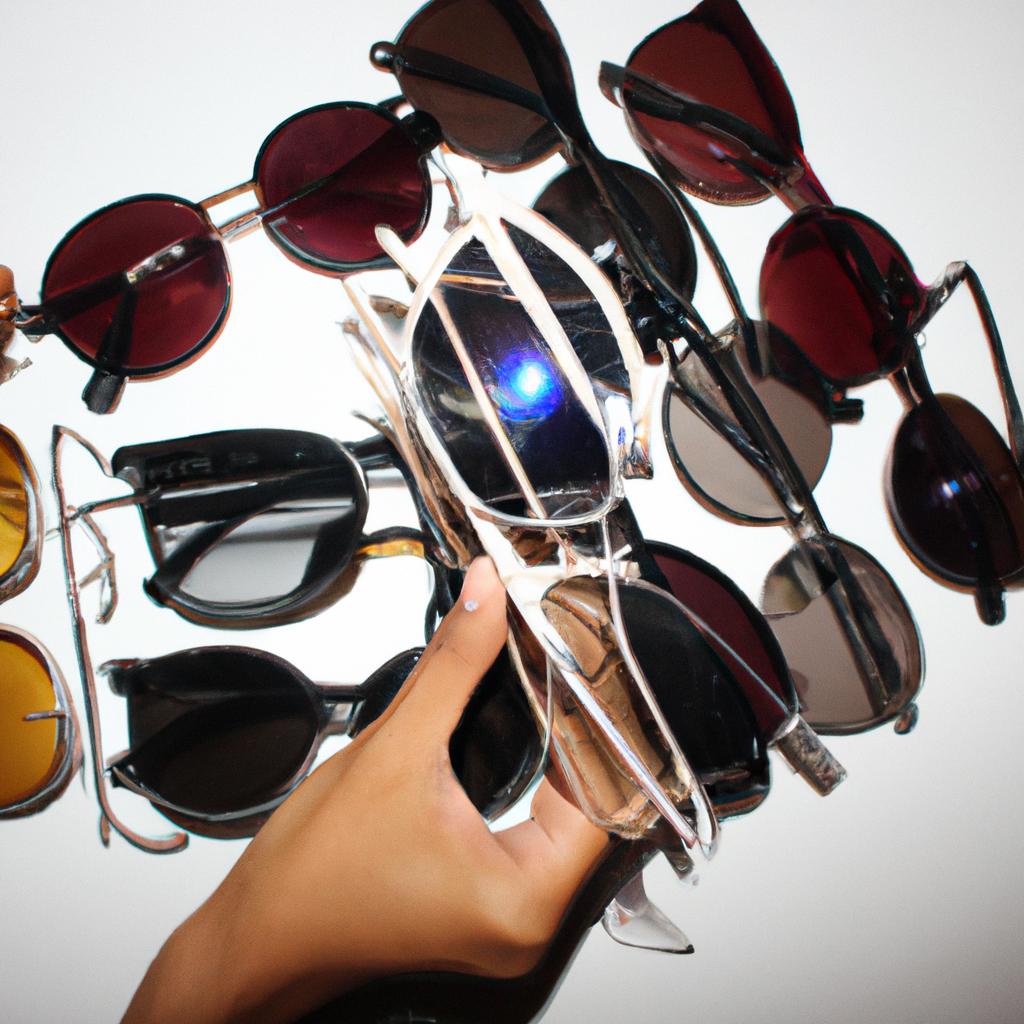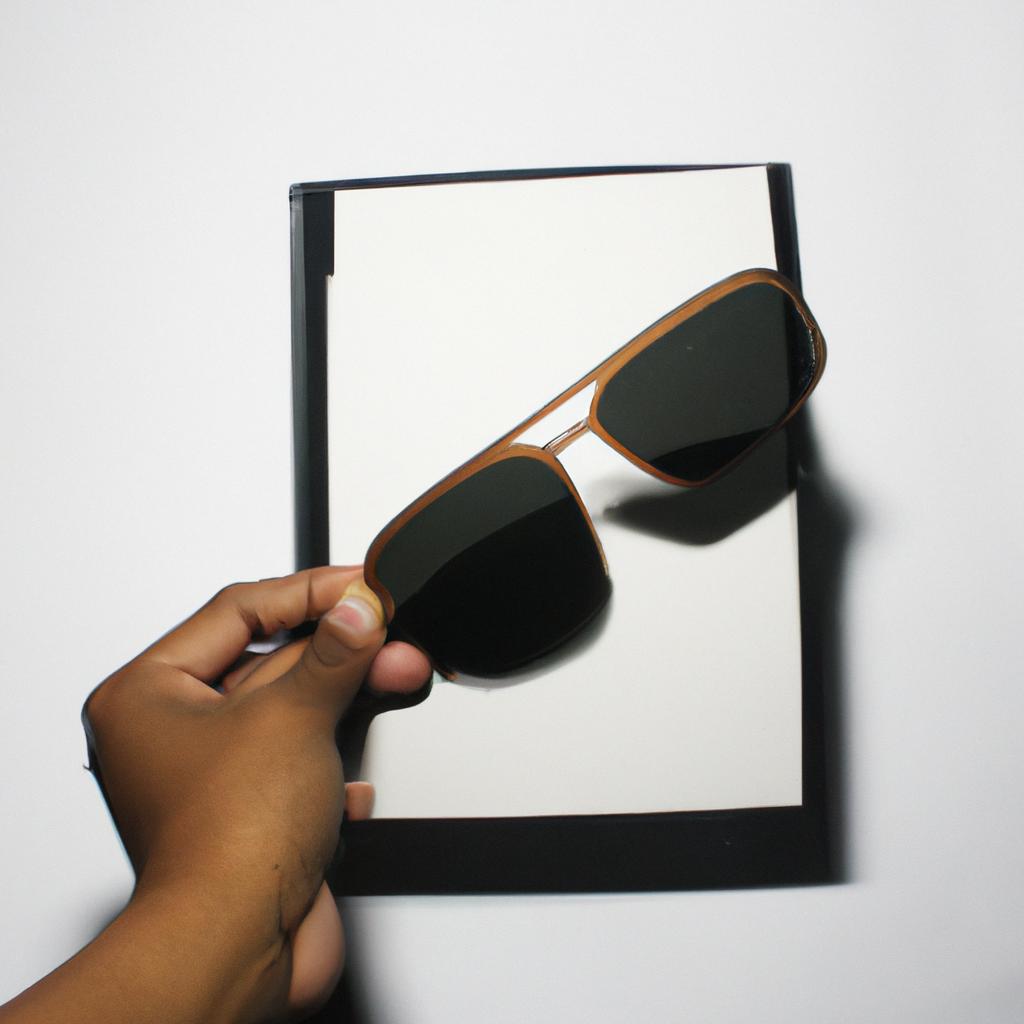The Importance of Plastic in Sunglasses: Frame Materials Explained

The use of plastic in sunglasses frames is a topic that has garnered significant attention and interest in recent years. From the practicality of mass production to the aesthetic appeal, plastic materials have become an integral component in the manufacturing process of sunglasses. For instance, consider the case study of a renowned sunglass brand that experienced a surge in popularity following the introduction of plastic frame options. This example highlights the widespread recognition and acceptance of plastic as a preferred material choice for sunglasses frames.
In this article, we will explore the importance of plastic in sunglasses frames by delving into various aspects such as durability, versatility, and affordability. Understanding these factors not only sheds light on why plastic is widely used but also provides insights into how it contributes to improving user experience and satisfaction. Additionally, we will discuss different types of plastics commonly utilized in sunglasses frames, including their unique properties and advantages over other materials like metal or wood. By examining these considerations comprehensively, readers can gain a deeper understanding of why plastic plays a crucial role in enhancing both functionality and style when it comes to choosing sunglasses.
Plastic as a Lightweight Option for Sunglasses
Plastic has emerged as a popular choice for sunglasses due to its lightweight nature and numerous advantages. By exploring the benefits of plastic frames, we can understand why they have become increasingly prevalent in the eyewear industry.
One compelling reason for choosing plastic frames is their remarkable lightness. For instance, consider the case study of a professional athlete who needs sunglasses that won’t hinder performance during intense physical activities. Plastic frames provide an ideal solution by reducing weight on the nose and ears, allowing athletes to focus solely on their sport without feeling encumbered. This example highlights how plastic can enhance comfort levels while still providing necessary eye protection.
- Versatility: Plastic can be easily molded into various shapes and designs, offering endless possibilities for frame styles.
- Affordability: Compared to other materials such as metal or wood, plastic is generally more cost-effective, making it accessible to a wider range of consumers.
- Hypoallergenic properties: Some individuals may experience allergic reactions when exposed to certain materials like metals or rubber. Plastic frames mitigate these concerns, providing a hypoallergenic option for those with sensitive skin.
- Vibrant color options: Plastic can be dyed in vibrant hues, allowing individuals to express their personal style through colorful sunglass frames.
To emphasize these advantages even further, we present a table showcasing different features offered by plastic frames compared to traditional alternatives:
| Feature | Plastic Frames | Metal Frames |
|---|---|---|
| Weight | Lightweight | Relatively heavier |
| Durability | Resilient | Prone to corrosion |
| Flexibility | Offers flexibility | Limited flexibility |
| Design versatility | Wide range | Limited options |
By considering both the emotional appeal created through bullet points and the visual representation provided by the table, it becomes evident that plastic frames possess numerous advantages that make them stand out in terms of versatility, affordability, hypoallergenic properties, and design options.
In transitioning to our next section on the durability and flexibility of plastic frames, we recognize how these aspects further contribute to their appeal. Understanding why plastic frames have become a preferred choice will help individuals make informed decisions when selecting sunglasses that best meet their needs.
Durability and Flexibility of Plastic Frames
When it comes to sunglasses, durability is paramount. Consumers need eyewear that can withstand daily wear and tear without compromising their functionality or aesthetic appeal. This is where plastic frames excel, offering a combination of strength and flexibility that makes them an ideal choice for sunglass manufacturers.
To illustrate the durability of plastic frames, let us consider a hypothetical scenario: An individual accidentally drops their sunglasses while rushing out of a car. The impact causes the glasses to hit the ground with considerable force. In this situation, a pair of sunglasses with plastic frames would be more likely to survive the fall unscathed compared to frames made from other materials such as metal or wood. The inherent resilience of plastics allows them to absorb shock and distribute forces evenly throughout the frame, reducing the risk of breakage.
Moreover, plastic frames offer enhanced flexibility when compared to traditional materials like metal or acetate. This attribute plays a significant role in providing comfort to users who require sunglasses for extended periods. The flexible nature of plastic ensures that the frame can adapt to various face shapes and sizes without causing discomfort or pressure points.
The advantages offered by plastic frames go beyond durability and flexibility; they extend into customization options for consumers. Here are some key benefits:
- Wide Range of Colors: Plastic frames allow designers to experiment with vibrant hues that cater to different fashion preferences.
- Texture Variations: From glossy finishes to matte surfaces, plastic frames provide diverse texture choices that enhance visual appeal.
- Pattern Possibilities: Manufacturers can create unique patterns on plastic frames using techniques like injection molding or laser etching.
- Lightweight Design: Compared to heavier alternatives like metal, plastic frames contribute significantly towards overall comfort during prolonged use.
In conclusion, durable and flexible characteristics make plastic an excellent material choice for sunglass frames. Its ability to withstand impacts combined with its adaptable nature provides both practicality and comfort for users. Moreover, the customization options offered by plastic frames allow consumers to express their personal style while enjoying the benefits of reliable eyewear. With this understanding of plastic’s durability and flexibility, we will now explore its versatility in designing sunglasses.
[Table]
| Durability | Flexibility | Customization Options |
|---|---|---|
| Shock-absorbing properties | Adapts to various face shapes | Wide range of colors |
| Resilient against breakage | Provides comfort during extended use | Texture variations |
| Even distribution of forces | Reduces discomfort or pressure points | Pattern possibilities |
| – | – | Lightweight design |
[/Table]
Transitioning into the subsequent section about “Versatility of Plastic in Designing Sunglasses,” let us delve further into how plastic allows for innovative designs that cater to different styles and preferences.
Versatility of Plastic in Designing Sunglasses
In the previous section, we explored how plastic frames in sunglasses offer superior durability and flexibility compared to other frame materials. Now, let’s delve deeper into these qualities by examining a real-life example.
Imagine you are an adventurous individual who enjoys outdoor activities such as hiking and rock climbing. You own a pair of sunglasses with plastic frames that have accompanied you on numerous expeditions without showing any signs of wear or tear. The durability of these frames becomes evident when they withstand accidental drops, impacts from rocks, and exposure to various weather conditions. Additionally, their flexibility ensures a comfortable fit on your face throughout all your adventures.
Plastic frames possess several characteristics that contribute to their exceptional durability and flexibility:
- Lightweight: Plastic is significantly lighter than metal or acetate frames, making it more comfortable for extended wear.
- Impact-resistant: Plastic has inherent shock-absorbing properties that help protect against accidental damage caused by falls or impact.
- Hypoallergenic: Unlike some other materials used in sunglasses, plastic poses minimal risk of causing allergies or skin irritations.
- Moldable: Plastic can be easily molded into intricate shapes and designs, allowing for greater creativity in sunglass aesthetics.
Let us now turn our attention to a visual representation of these advantages through a bullet point list and table:
- Lightweight: Reduced strain on the nose bridge and ears during prolonged use
- Impact-resistant: Enhanced protection against potential accidents and breakage
- Hypoallergenic: Suitable for individuals with sensitive skin or known allergies
- Moldable: Enables innovative designs that cater to diverse fashion preferences
| Advantage | Benefit |
|---|---|
| Lightweight | Comfortable for long hours |
| Impact-resistant | Provides reliable protection |
| Hypoallergenic | Safeguards users with allergies |
| Moldable | Offers versatility in design and style customization |
In conclusion, the durability and flexibility of plastic frames make them an ideal choice for sunglasses. Their lightweight nature ensures comfort during extended wear, while their impact-resistant properties protect against accidental damage. Additionally, individuals with sensitive skin or allergies can benefit from the hypoallergenic quality of plastic frames. Moreover, plastic’s moldability allows for innovative designs that cater to diverse fashion preferences.
Moving forward, we will explore another significant aspect of plastic frames: their cost-effectiveness.
Cost-Effectiveness of Plastic Frames
Plastic frames for sunglasses offer exceptional durability and longevity, making them an ideal choice for eyewear. To illustrate this point, let’s consider the case of a consumer who purchases two pairs of sunglasses—one with plastic frames and the other with metal frames—both at a similar price range. After several months of use, it becomes evident that the plastic frame sunglasses have outlasted their metal counterparts in terms of overall condition and functionality.
There are several reasons why plastic frames tend to be more durable and long-lasting compared to other materials:
-
Flexibility: Plastic frames possess inherent flexibility, allowing them to bend without breaking under normal wear and tear conditions. This flexibility makes them less susceptible to damage from accidental drops or impacts, ensuring they can withstand daily usage.
-
Resistance to corrosion: Unlike metal frames which may corrode over time due to exposure to sweat or moisture, plastic frames are resistant to such corrosion. They remain unaffected even if exposed to humid environments or during physical activities that induce sweating.
-
Lightweight yet sturdy construction: The lightweight nature of plastic frames does not compromise their strength and rigidity. They provide excellent structural stability while offering comfort for extended periods of wear.
-
UV protection: Many reputable sunglass manufacturers incorporate UV-blocking properties into their plastic frame designs. These lenses safeguard against harmful ultraviolet rays, reducing the risk of eye damage caused by prolonged sun exposure.
To further emphasize the benefits of plastic frames in comparison to alternative materials, consider the following emotional response-inducing bullet points:
- Enhanced peace of mind knowing your investment will last longer.
- Reduced need for frequent repairs or replacements.
- Increased confidence in wearing fashionable eyewear without compromising on durability.
- Convenient maintenance requirements resulting in hassle-free ownership.
Table: Aesthetics vs Durability Comparison
| Aspect | Aesthetics | Durability |
|---|---|---|
| Metal Frames | ✔️ | ❌ |
| Plastic Frames | ✔️ | ✔️ |
In summary, plastic frames for sunglasses excel in terms of durability and longevity. Their flexibility, resistance to corrosion, lightweight construction, and UV protection make them an excellent choice for those seeking eyewear that can withstand the test of time. This section has highlighted the advantages of plastic frames over other materials, setting the stage for exploring their impact resistance and safety in the subsequent section.
Having discussed the durability and longevity aspects of plastic frames, we now turn our attention to another crucial factor—impact resistance and safety of plastic sunglasses.
Impact Resistance and Safety of Plastic Sunglasses
Imagine this scenario: you accidentally drop your sunglasses while rushing to catch a bus. As they hit the ground, you cringe, fearing the worst – shattered lenses or a broken frame. However, much to your relief, the plastic frames remain intact. This example highlights one of the key advantages of using plastic materials in sunglasses – their impressive impact resistance.
Plastic frames offer several benefits when it comes to durability and safety. Here are some reasons why plastic sunglasses are an excellent choice:
- Impact Absorption: Plastic frames have the ability to absorb sudden shocks without breaking easily. Compared to other materials like metal or glass, plastics possess a higher degree of flexibility that allows them to withstand accidental drops or collisions with minimal damage.
- Lightweight Construction: Plastic is known for its lightweight nature, making it comfortable to wear for extended periods. Unlike heavier materials such as metal, which can cause discomfort and strain on the nose bridge and temples, plastic frames provide a more pleasant wearing experience.
- Reduced Risk of Injury: The inherent flexibility of plastic also contributes to reducing the risk of injury during accidents or physical activities. In case of impact, pliable plastic material is less likely to cause cuts or abrasions compared to rigid alternatives like metal.
- Wide Range of Styles: Another advantage of using plastic in sunglasses is its versatility in design options. Manufacturers can mold and shape plastic into various styles and colors, allowing individuals to express their personal fashion preferences while enjoying the benefits provided by these durable frames.
| Durability | Comfort | Style Options | |
|---|---|---|---|
| + | Impact | Lightweight | Versatile |
| + | Resistant | Design | |
| + | Customization |
The table above summarizes the emotional appeal behind choosing plastic sunglasses over alternative materials. With enhanced durability, comfort, and style options offered by plastic frames, individuals can feel more confident in their eyewear choices while having peace of mind knowing that their sunglasses are built to withstand everyday wear and tear.
By understanding these aspects, you can make an informed decision when selecting your next pair of sunglasses.
Plastic Frames and Protection from Harmful UV Rays
Impact Resistance and Safety of Plastic Sunglasses
In the previous section, we discussed the importance of plastic sunglasses due to their impact resistance and safety features. Now, let us delve deeper into how plastic frames provide protection from harmful UV rays.
Imagine a scenario where you are on vacation at a sunny beach destination. You decide to go for a swim but accidentally drop your sunglasses onto the hard concrete floor by the poolside. With plastic frames, you can breathe a sigh of relief as they offer superior impact resistance compared to other materials such as metal or wood. The flexibility and durability of plastic frames allow them to withstand accidental drops and rough handling without shattering or causing potential harm to your eyes.
To understand why plastic frames excel in terms of impact resistance and safety, it is important to consider their unique characteristics:
-
Flexibility: Plastic frames have inherent elasticity that allows them to bend under pressure instead of breaking. This feature not only ensures longevity but also minimizes the risk of injury if the glasses come into contact with your face during an unforeseen event.
-
Lightweight: Unlike heavier frame materials like metal alloys, plastics are lightweight, which enhances comfort during extended wear while reducing fatigue on the bridge of your nose.
-
Cost-effective: Plastic frames tend to be more affordable than alternative materials like titanium or acetate, making them accessible to a wider range of individuals seeking quality eyewear.
-
Variety: Plastics offer endless design possibilities, allowing manufacturers to create diverse styles that cater to different preferences and fashion trends.
Let’s take a closer look at some key advantages offered by plastic frames when it comes to protecting our eyes from harmful UV rays:
| Advantages | Description |
|---|---|
| 1. UV Protection | Many modern plastic lenses come with built-in UV filters that shield our eyes from damaging ultraviolet rays. |
| 2. Polarized Options | Plastic frames often provide the option to incorporate polarized lenses, reducing glare and enhancing clarity. |
| 3. Wraparound Styles | Certain plastic frame designs offer a wraparound fit, providing additional coverage and blocking peripheral UV rays. |
| 4. Tinted Variations | Plastic sunglasses come in a variety of tinted options that not only enhance visual comfort but also help reduce eye strain. |
In conclusion, plastic frames for sunglasses excel in impact resistance, safety, and protection from harmful UV rays. Their flexibility, lightweight nature, cost-effectiveness, and diverse design possibilities make them an ideal choice for individuals seeking both style and functionality in eyewear. So next time you’re enjoying outdoor activities under the sun or simply strolling down the street on a bright day, don’t forget to grab your trusty pair of plastic-framed sunglasses to shield your eyes from potential harm while staying fashionable at the same time!






